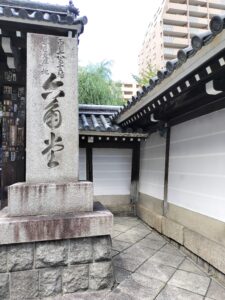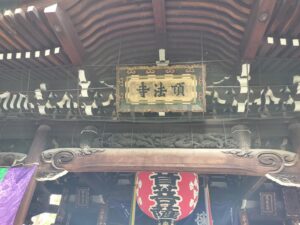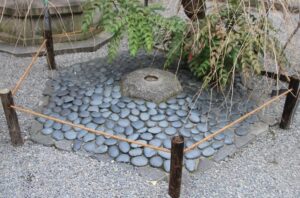The main hall of Choho-ji Temple has a hexagonal shape and is called “Rokkakudo”, Hexagonal Hall. Choho-ji Temple is the 18th temple of Saigoku 33 Kannon Pilgrimage.
 The Stone Monument at the Entrance of Choho-ji Temple
The Stone Monument at the Entrance of Choho-ji Temple
Prince Shotoku had a nenjibutsu (a small statue of Buddha always kept close at hand) which was a statue of Nyoirin Kannon (Cintamani-cakva) was cast ashore at Awaji Island. In 587, Prince Shotoku visited Kyoto Basin looking for lumbers to build Shitenno-ji Temple in Osaka. It is said that he hung the nenjibutsu on a tree to cleanse himself at a pond and the nenjibutsu never moved and told him the nenjibutsu would like to save people by staying in this area. Then, Price Shotoku built a hexagonal hall and placed the nenjibutsu in the hall. The official name of the temple is Choho-ji Temple, but people call it Rokkakudo or Rokkaku-san per the shape of the hall. Also, the avenue in front of the temple is called Rokkaku Avenue.
 The Rokkakudo (The Main Hall)
The Rokkakudo (The Main Hall)
From the beginning of the temple history, many people felt reverence for the temple. In 822, the temple was used as Emperor Saga’s place of imperial prayer. Also, in 996, Cloistered Emperor Kazan visited this temple and became the 18th temple of Saigoku 33 Kannon Pilgrimage.
In 1201, Shinran Shonin confined himself in Choho-ji Temple to pray for 100 days and got the words of gods. This was a base for his start of the Jodo-Shin (True Pure Land) sect.
In the main hall, Rokkakudo, there are the statue of Nyoirin Kannon (Cintamani-cakva) which was the nenjibutsu of Prince Shotoku, a statue of Shinran Shonin, and a standing statue of Vaisravana (important cultural property).
 The Heso Ishi (Navel Stone)
The Heso Ishi (Navel Stone)
There is a hexagonal stone called Heso Ishi in front of the main hall. This was originally a cornerstone of the old main hall. From old times, it is said that this stone is located in the center of Kyoto.
There is a head priest temple’s quarters in the north part of the temple called “Ikenobo”. After Muromachi Period, Ikenobo produced many experts of flower arrangements.




Comments